 Who am I
Instrumental
Minimalism
Projects
Recordings
Help
E-mail me
|
Version
Española Aquí
Combinaciones
3 a 3
A theme divided in four movements
for guitar, bass, keyboards and drums:
Movement
I (Sample) - c331.mp3 - 316 Kb
Movement
II (Sample) - c332.mp3 - 257 Kb
Movement
III (Sample) - c333.mp3 - 135 Kb
Movement
IV (Sample) - c334.mp3 - 226 Kb
Combination
Method.
I have begun experimenting with elements extracted
from maths, using them in music. This is not new, I
know. There are lots of composers that base their
music in maths, but you can say that maths belong to
music itself. Anyway I am going to use this site to
comment one of my methods.
The base idea is the mathematic topic 'combination
with repetitions'. I'll try to explain this idea in a
single way. Let's take three elements: A, B and C.
You can create with them groups of three elements as
following: ABC, ACB, CBA, and so on. If you repeat an
element in a group, then you can get combination like
these: AAA, BBB, ABB, CCB, CCA, CCC, and so on. Then
you say you are creating patterns using three
elements (A, B, C) taken in groups consisting in
three elements, which can be repeated in these
groups.
In this example, the number of resulting
combinations (groups) is 27. These patterns are the
following: AAA, BBB, CCC, AAB, ABA, BAA, AAC, ACA,
CAA, BBA, BAB, ABB, BBC, BCB, CBB, CCA, CAC, ACC,
CCB, CBC, BCC, ABC, BCA, CAB, CBA, BAC, ACB.
Well, let's see how to use this idea in the field
of music. The firt step is to take three rhythmic
patterns: A, B and C. Then I create a three chord
progression: 1, 2 and 3. After that I apply each
rythmic pattern on each chord. For example, if I use
the pattern A with the chord number 1 I get the
pattern A1.

If I join three of the resulting patterns,
following the chord progression, I get 27 different
combinations: A1A2A3, A1B2C3, C1A2C3, B1A2C3, and so
on.

I use this idea with all the instrumental lines of
the piece, and then I play the 27 groups without
pause between them, sorting them as I prefer. I can
play the 27 groups twice o more adding and deleting
instruments in order to add complexity to the
composition. There are lots of possibilities. Though
I only use combinations of three elements taken in
groups of three, you can use other combination models
(four elements taken in groups of two, three elements
taken in groups of four, and so on.)
Combinations.
Movement IV.
In order to understand correctly the "Combination
Method" I show here an example based in a
theme of my own. The title in spanish is Combinaciones
3 a 3. Nº 4, it is 8 minutes long and it is
written for keyboards, electric bass, electric guitar
and drums. The example has been extracted from the
line of the electric guitar.
As I explained before, the "Combination
Method" consist in taking a group of musical
patterns and combine them in all the possible ways.
In this composition I take three patterns (A, B and
C), each of them with three harmonic variants (1, 2
and 3). The result are 9 patterns: A1, A2, A3, B1,
B2, B3, C1, C2 and C3 which are combined in a
determinated way in order to create the line of the
electric guitar. I use this method with all the
instrumental lines.
Here you have the three variants of the pattern A:

Here, the pattern B variants:

And here the pattern C:

In this example there are 27 combinations, that
are sorted for this composition in this way:
A1A2A3 / B1B2B3 / C1C2C3
/ C1A2A3 / A1C2A3 / A1A2C3
/ C1C2A3 etc...
Having in mind the list above, the line of
electric guitar begins in this way:

Combinaciones 3 a 3. Nº 4 begins with the
keyboard playing the 27 combinations. Then, it begins
again but with the electric guitar, the bass and
drums playing a simple and repetitive rhythm. These
instruments are not very usual in minimal music so
this theme doesn't sound as "conventional
minimal music". I try with this to compose very
personal music although this is based in a style
invented by other composers.
All themes registered
|


